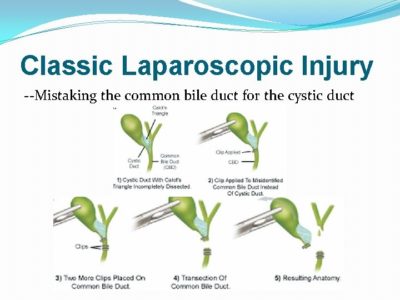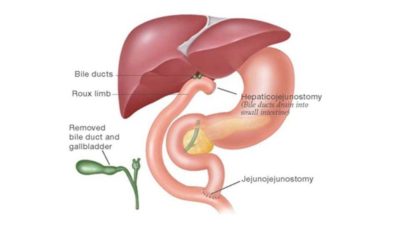BILIARY ATRESIAY
Patient Education Material
The Gallbladder is a small, sac-like organ that sits under the liver on the right side of your abdomen (belly). The gallbladder stores a greenish fluid called bile. Bile is made and released by the liver and then sent to the small intestine. where it helps the body break down and absorb food. Bile moves through a network of tube-like structures called bile ducts.

Gallbladder Surgery:
Sometimes, small, hard masses called gallstones form inside the gallbladder. These stones can cause swelling, pain, and infection. They can also damage the gallbladder. Gallstone disease is one of the most common digestive system disorders. It is the most common reason for gallbladder surgery. Surgery to remove a diseased gallbladder is called a cholecystectomy. You can live normally without a gallbladder, but you might need to make some changes in your diet.
More about Gallbladder surgery:
A common type of gallbladder surgery, called laparoscopic cholecystectomy, is done through a few small cuts in the abdomen. For this type of surgery, a camera and light are attached to the scope and placed into one of the small cuts. The camera projects a live-action video of the inside of the abdomen onto a screen near the surgical table. The doctor looks at the screen and uses the video to guide his or her movements. The doctor then takes out the gallbladder with surgical tools placed in the other small cuts.
The benefits of laparoscopic cholecystectomy over open surgery include less pain. less time in the hospital and quicker recovery. It is now considered the “gold standard” for surgical treatment of gallbladder disease.
A bile duct injury is a damage to the bile ducts that happens during gallbladder surgery. A bile duct can get cut, burned, or pinched. As a result of an injury, the bile duct will not be able to work right. leaking bile into the abdomen or blocking the normal flow of bile from the liver. Bile duct injuries lead to symptoms that can be painful, even deadly, if not treated.
The numbers vary by study. Some estimate that bile duct injuries occur in one in 1,000 cases of laparoscopic gallbladder surgery. They appear to occur less often in open surgeries.
Causes of Bile Duct injuries during Gallbladder surgery:
Most bile duct injuries that occur during gallbladder surgery happen because the area around the gallbladder and bile ducts is masked in some way so that the doctor cannot see it clearly. This can happen if the area’s structure (anatomy) is different than normal, or if there is a lot of bleeding, swelling, or scarring in the area.

Symptoms of Bile Duct Injuries:
Patients with bile duct injury after a laparoscopic cholecystectomy may experience symptoms soon after surgery, or several weeks to months after the injury occurred.
Patients with early onset of symptoms, usually present with leakage of bile into the abdominal cavity. Some of the symptoms that associated with this include:
- Persistent pain and discomfort
- Nausea and/or vomiting
- Fever
- Jaundice
Since patients generally recover rapidly after laparoscopic cholecystectomy. Physicians should carefully evaluate patients who not improving for possible bile duct injury from laparoscopic cholecystectomy.
Patients who develop delayed symptoms from a bile duct injury usually scarring of the bile duct from the injury. This leads to the narrowing of the bile duct (bile duct stricture) so that bile cannot pass through. These patients experience jaundice as their primary symptom.
Duct injuries during Gallbladder surgery:
In about 10% to 30% of cases, bile duct injuries are found by the doctor at the time of surgery. He or she might notice leaking bile or blockage by sight or by using a test called intraoperative cholangiography (IOC). IOC is an X-ray exam of the bile ducts after a dye is injected to make the flow of bile clearly visible on the X-ray image.
If your injury was not found during surgery, tests your doctor might use to help diagnose a bile duct injury include:
- Abdominal ultrasound: This test uses sound waves and echoes to create images of the organs in the abdomen.
- Endoscopic retrograde cholangiopancreatography (ERCP): This test uses alighted. Flexible scope inserted into the upper part of the digestive system to look at and take X-rays of the bile ducts. Sometimes, bile duct injuries can also be treated using ERCP.
- Percutaneous transhepatic cholangiography (PTC): Like IOC, during this test, X-rays are taken after a dye is injected into the bile ducts.
- Magnetic resonance cholangiopancreatography (MRCP): This test uses magnetic resonance imaging, which uses a large magnet and radio waves to create images of the inside of the body, to view the bile ducts.
Bile Duct injuries from Gallbladder surgery treated:
If you’re experiencing any of the symptoms of bile duct injury after gallbladder surgery. it’s important to seek proper evaluation and treatment from a healthcare expert experienced in the diagnosis and treatment of bile duct injuries, as well as other hepatobiliary conditions.
The first goal of treatment is to manage any infection, leakage, or blockage caused by the injury. Then, the doctor may need to reconstruct the bile duct, often using a piece of intestine to bypass the blockage or the area where the duct was cut or burned.

The outcome depends on the type and extent of the injury and how soon the injury is found. Most bile duct injuries can successfully be repaired, and the patient can go on to a good quality of life. In severe cases, with more than one surgery, many months of recovery might need.
Kindly contact:
-
One PKLI Avenue, DHA, Phase-6, Lahore, Pakistan.
-
+92 42 111 117 554

